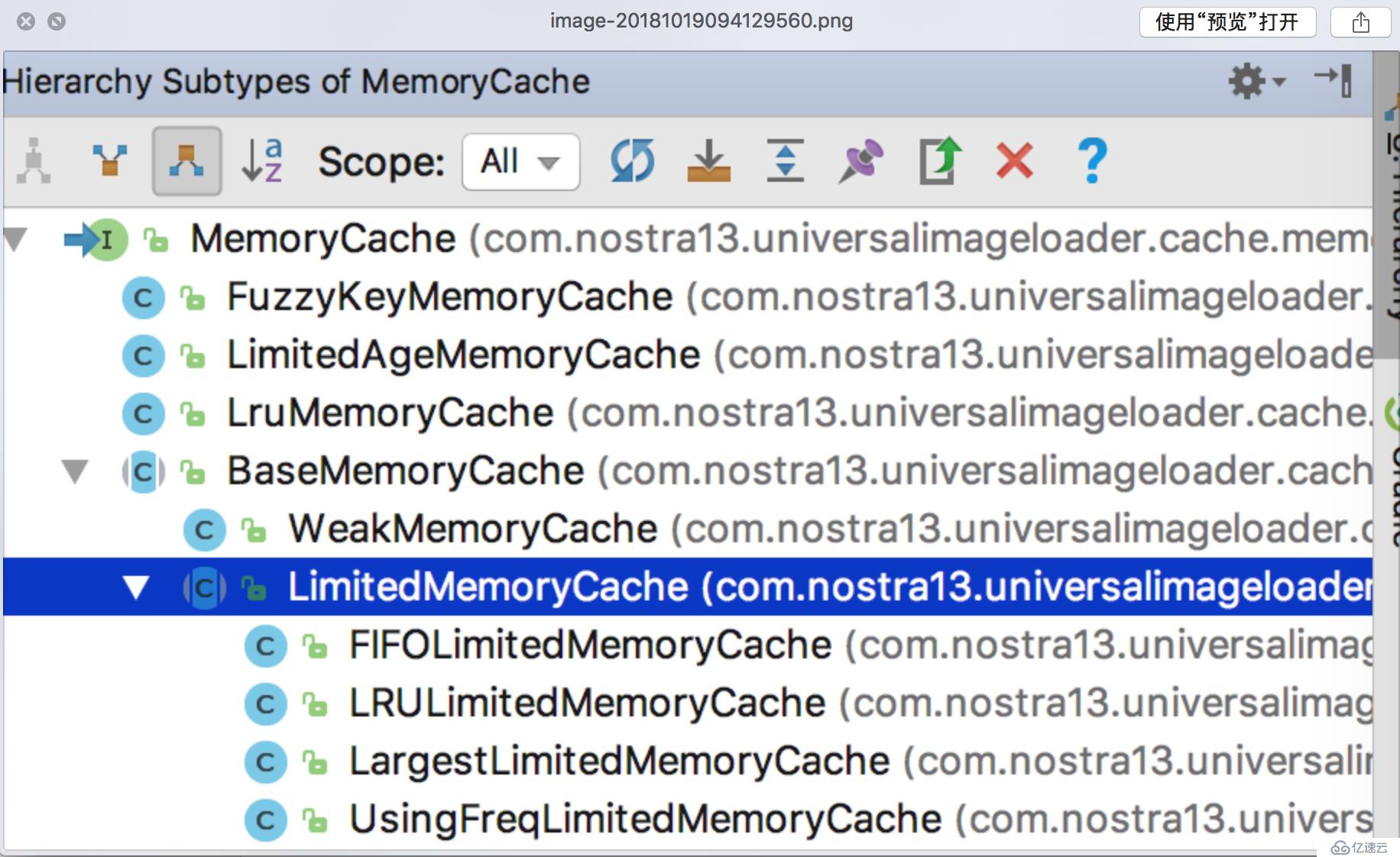您好,登录后才能下订单哦!
图片内存缓存可以提高图片显示速度,但是有些问题,比如占用内存,如果不加以控制,甚至可能会OOM
所以,需要提供各种各样的算法来控制内存的使用,以适应不同的使用场景,目前,ImageLoader提供了若干内存管理算法。
默认内存缓存是关闭的,需要手动打开

| 算法 | 解释 |
|---|---|
| MemoryCache | Interface 内存缓存的接口 |
| MemoryCache | Interface 内存缓存的接口 |
| FuzzyKeyMemoryCache | 模糊Key内存缓存,一些不同的Key可能会被认为是相同(通过equals方法)。当你put一个值到cache里面时,equals相同的Key也会被替换。这是一个内部功能,通常我们不需要使用到它。 |
| LimitedAgeMemoryCache | 限制时间内存缓存,如果一些对象的使用时间超过了定义的值,那么就会移除。比如最大时间设置成60s,那么如果一个对象是60s前put进来的,那么它就会失效。 |
| LruMemoryCache | 一个强引用的图片,限制图片使用数量的内存缓存,每个被访问的图片都会移动到队列的头部。当一个图片添加到一个满的队列的时候,队尾的图片将会被驱逐而被垃圾回收器回收。 |
| BaseMemoryCache | 抽象类,基本的图片缓存管理,提供了图片存储(强引用或者弱引用),具体的可以看下面的MemoryCache实现。 |
| WeakMemoryCache | 继承自BaseMemoryCache,弱引用内存缓存,弱引用,当内存不足的时候,会被系统回收。 |
| LimitedMemoryCache | 抽象类,继承自BaseMemoryCache,限制内存的内存管理抽象类,包括下面4个具体实现。提供图片对象存储,存储的所有的图片大小将不会超过大小限制。这个缓存提供了强引用和弱引用存储了图片,强引用用来限制图片大小,弱引用用来其他缓存的图片。 |
| FIFOLimitedMemoryCache | 继承自LimitedMemoryCache,存储的图片大小不小超过限定的大小。当缓存图片到达指定大小时,会按照FIFO(先进先出)的原则清理图片。 |
| LRULimitedMemoryCache | 继承自LimitedMemoryCache,存储的图片大小不小超过限定的大小。当缓存图片到达指定大小时,最早使用的图片会从缓存中删除。 |
| LargestLimitedMemoryCache | 继承自LimitedMemoryCache,存储的图片大小不小超过限定的大小。当缓存图片到达指定大小时,最大的图片会从缓存中删除。 |
| UsingFreqLimitedMemoryCache | 继承自LimitedMemoryCache,存储的图片大小不小超过限定的大小。当缓存图片到达指定大小时,最少使用频率的图片会从缓存中删除。 |
下面,我们会具体看各个MemoryCache的实现
public class LimitedAgeMemoryCache implements MemoryCache {
private final MemoryCache cache;
private final long maxAge;
private final Map<String, Long> loadingDates = Collections.synchronizedMap(new HashMap<String, Long>());
@Override
public boolean put(String key, Bitmap value) {
boolean putSuccesfully = cache.put(key, value);
if (putSuccesfully) {
loadingDates.put(key, System.currentTimeMillis());
}
return putSuccesfully;
}
@Override
public Bitmap get(String key) {
Long loadingDate = loadingDates.get(key);
if (loadingDate != null && System.currentTimeMillis() - loadingDate > maxAge) {
cache.remove(key);
loadingDates.remove(key);
}
return cache.get(key);
}
} 实现的方法很简单,在put的时候,用一个Map记录了存入的时间,get的时候,判断时间是否大于maxAge,如果是,那么就删掉这个缓存。
public class LruMemoryCache implements MemoryCache {
private final LinkedHashMap<String, Bitmap> map;
private final int maxSize;
@Override
public final boolean put(String key, Bitmap value) {
...
synchronized (this) {
size += sizeOf(key, value);
Bitmap previous = map.put(key, value);
if (previous != null) {
size -= sizeOf(key, previous);
}
}
trimToSize(maxSize);
return true;
}
private void trimToSize(int maxSize) {
while (true) {
String key;
Bitmap value;
synchronized (this) {
if (size < 0 || (map.isEmpty() && size != 0)) {
throw new IllegalStateException(getClass().getName() + ".sizeOf() is reporting inconsistent results!");
}
if (size <= maxSize || map.isEmpty()) {
break;
}
Map.Entry<String, Bitmap> toEvict = map.entrySet().iterator().next();
if (toEvict == null) {
break;
}
key = toEvict.getKey();
value = toEvict.getValue();
map.remove(key);
size -= sizeOf(key, value);
}
}
}
} 实现的原理是利用LinkedHashMap,先存入的key在遍历的时候在链表的头部,所以在put值的时候,从头开始遍历HashMap,从头删除图片缓存,直到内存的大小在指定大小以内。
另外为了防止多线程的问题,put和trimToSize删除图片的时候做了synchronized同步。
这个也是ImageLoader使用比较多的一种内存管理方法。
public class WeakMemoryCache extends BaseMemoryCache {
@Override
protected Reference<Bitmap> createReference(Bitmap value) {
return new WeakReference<Bitmap>(value);
}
}实现方法很简单,用一个弱引用就可以解决,用弱引用包裹了图片。
FIFOLimitedMemoryCache继承自抽象类LimitedMemoryCache,所以看算法实现前还要看LimitedMemoryCache代码。
抽象类LimitedMemoryCache和其实现子类的关系是LimitedMemoryCache put的时候限定超过大小时调用removeNext删除图片缓存;
但是具体怎么删,删除什么图片缓存,就由子类实现。
public abstract class LimitedMemoryCache extends BaseMemoryCache {
@Override
public boolean put(String key, Bitmap value) {
boolean putSuccessfully = false;
// Try to add value to hard cache
int valueSize = getSize(value);
int sizeLimit = getSizeLimit();
int curCacheSize = cacheSize.get();
if (valueSize < sizeLimit) {
while (curCacheSize + valueSize > sizeLimit) {
Bitmap removedValue = removeNext();
if (hardCache.remove(removedValue)) {
curCacheSize = cacheSize.addAndGet(-getSize(removedValue));
}
}
hardCache.add(value);
cacheSize.addAndGet(valueSize);
putSuccessfully = true;
}
// Add value to soft cache
super.put(key, value);
return putSuccessfully;
}
}
public class FIFOLimitedMemoryCache extends LimitedMemoryCache {
private final List<Bitmap> queue = Collections.synchronizedList(new LinkedList<Bitmap>());
...
@Override
protected Bitmap removeNext() {
return queue.remove(0);
}
}用list实现,直接从头开始移除。
public class LRULimitedMemoryCache extends LimitedMemoryCache {
/** Cache providing Least-Recently-Used logic */
private final Map<String, Bitmap> lruCache = Collections.synchronizedMap(new LinkedHashMap<String, Bitmap>(INITIAL_CAPACITY, LOAD_FACTOR, true));
@Override
protected Bitmap removeNext() {
Bitmap mostLongUsedValue = null;
synchronized (lruCache) {
Iterator<Entry<String, Bitmap>> it = lruCache.entrySet().iterator();
if (it.hasNext()) {
Entry<String, Bitmap> entry = it.next();
mostLongUsedValue = entry.getValue();
it.remove();
}
}
return mostLongUsedValue;
}
}使用一个 LinkedHashMap lruCache来保存图片的put顺序,需要移除的时候(removeNext)从lruCache找到第一张图片即可。
public class UsingFreqLimitedMemoryCache extends LimitedMemoryCache {
private final Map<Bitmap, Integer> usingCounts = Collections.synchronizedMap(new HashMap<Bitmap, Integer>());
@Override
public Bitmap get(String key) {
Bitmap value = super.get(key);
// Increment usage count for value if value is contained in hardCahe
if (value != null) {
Integer usageCount = usingCounts.get(value);
if (usageCount != null) {
usingCounts.put(value, usageCount + 1);
}
}
return value;
}
@Override
protected Bitmap removeNext() {
Integer minUsageCount = null;
Bitmap leastUsedValue = null;
Set<Entry<Bitmap, Integer>> entries = usingCounts.entrySet();
synchronized (usingCounts) {
for (Entry<Bitmap, Integer> entry : entries) {
if (leastUsedValue == null) {
leastUsedValue = entry.getKey();
minUsageCount = entry.getValue();
} else {
Integer lastValueUsage = entry.getValue();
if (lastValueUsage < minUsageCount) {
minUsageCount = lastValueUsage;
leastUsedValue = entry.getKey();
}
}
}
}
usingCounts.remove(leastUsedValue);
return leastUsedValue;
}
}使用一个HashMap usingCounts来存储bitmap的使用次数,每次get的时候都会让使用次数+1,那需要移除的时候图片缓存的时候,遍历usingCounts,找到使用次数最少的图片,删除之。
不过这种遍历的算法感觉效率不高,慎用!
免责声明:本站发布的内容(图片、视频和文字)以原创、转载和分享为主,文章观点不代表本网站立场,如果涉及侵权请联系站长邮箱:is@yisu.com进行举报,并提供相关证据,一经查实,将立刻删除涉嫌侵权内容。